The route for the 2023 Paris-Nice is out and here’s a more detailed stage-by-stage look at the route ahead between Sunday 5 – Sunday 12 March.
The novelty is the team time trial, back after a 30 year absence and with an innovative new rule change as well.
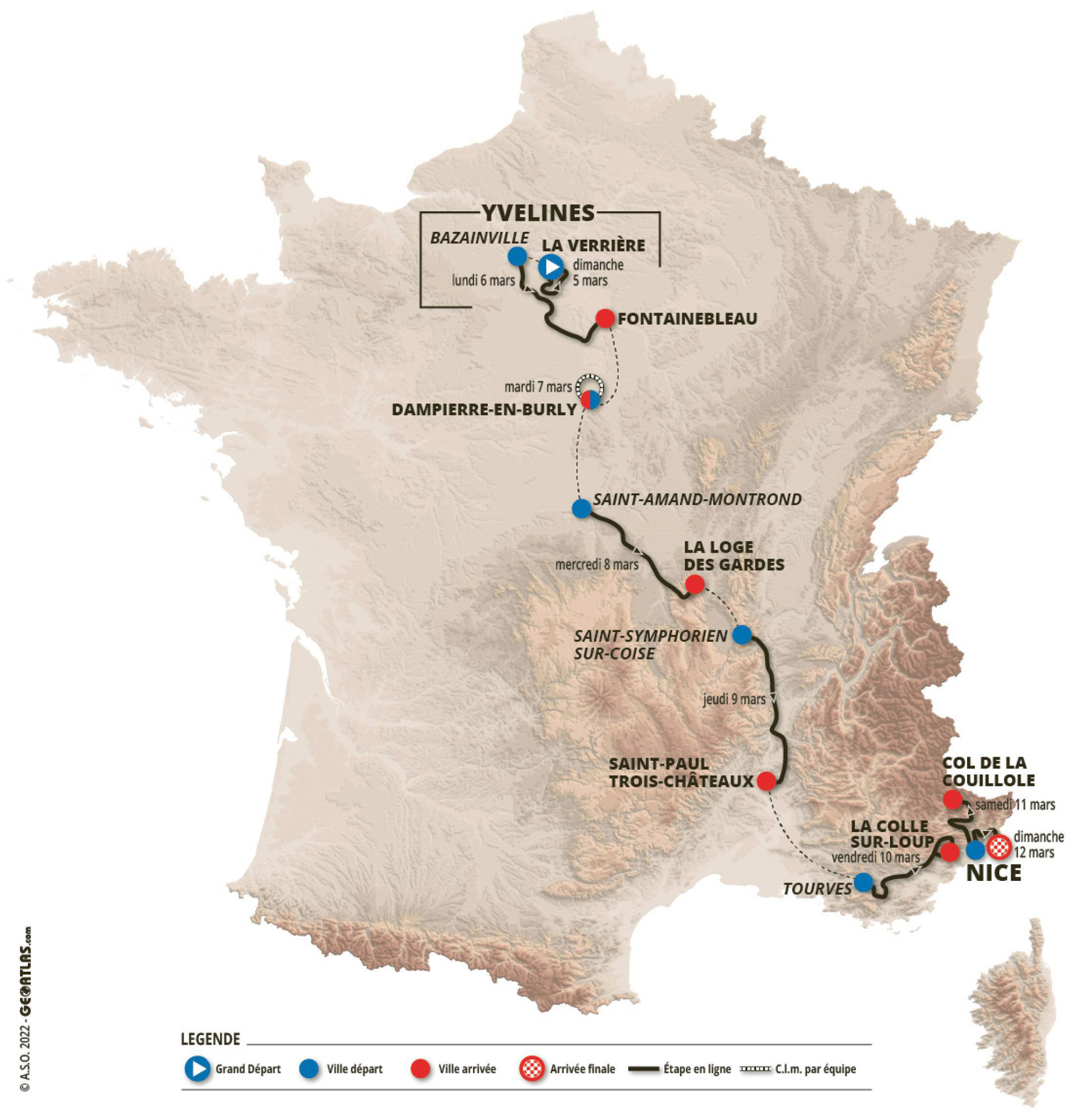
Stage 1

The traditional opening stage in the Yvelines department to the west of Paris, race organisers ASO have a long-term contract to start the race here. There are familiar roads in the Chevreuse valley including the Côte des 17 Tournants – climb of the 17 bends – but hardly Alpe d’Huez’s Parisian cousin, the 17 bends are more slight kinks in the road but it’s still a climb where being at the front is advantageous before the finish in La Verrière.
Stage 2
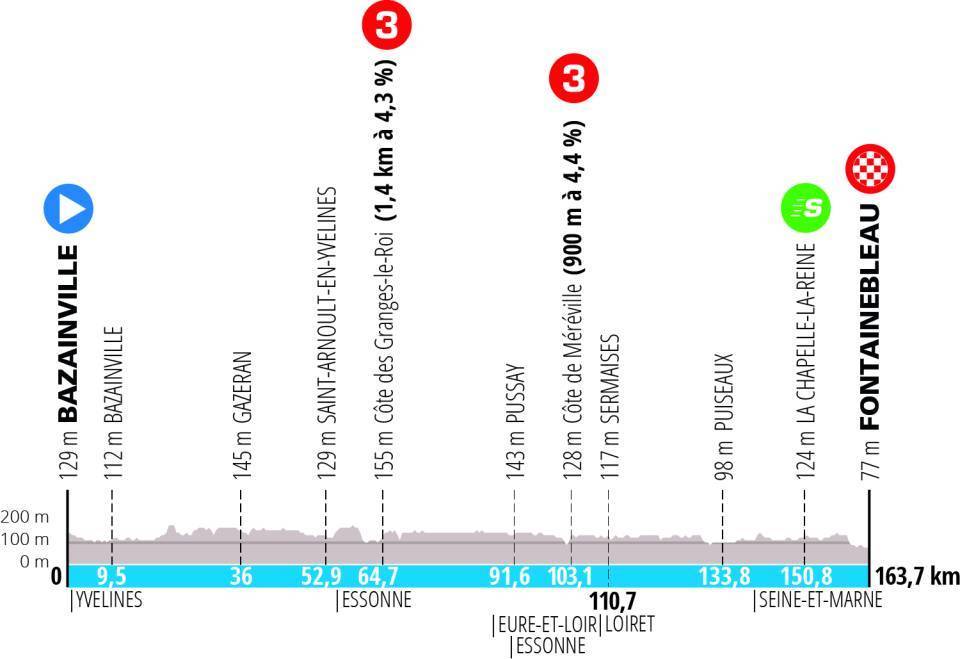
Flat to Fontainebleau but not a straight line. The X-factor is the weather forecast because if the wind gets up, and a breeze is sufficient given the exposed terrain, then the peloton can be split to pieces and the course with its change in direction seems designed with this in mind.
Stage 3
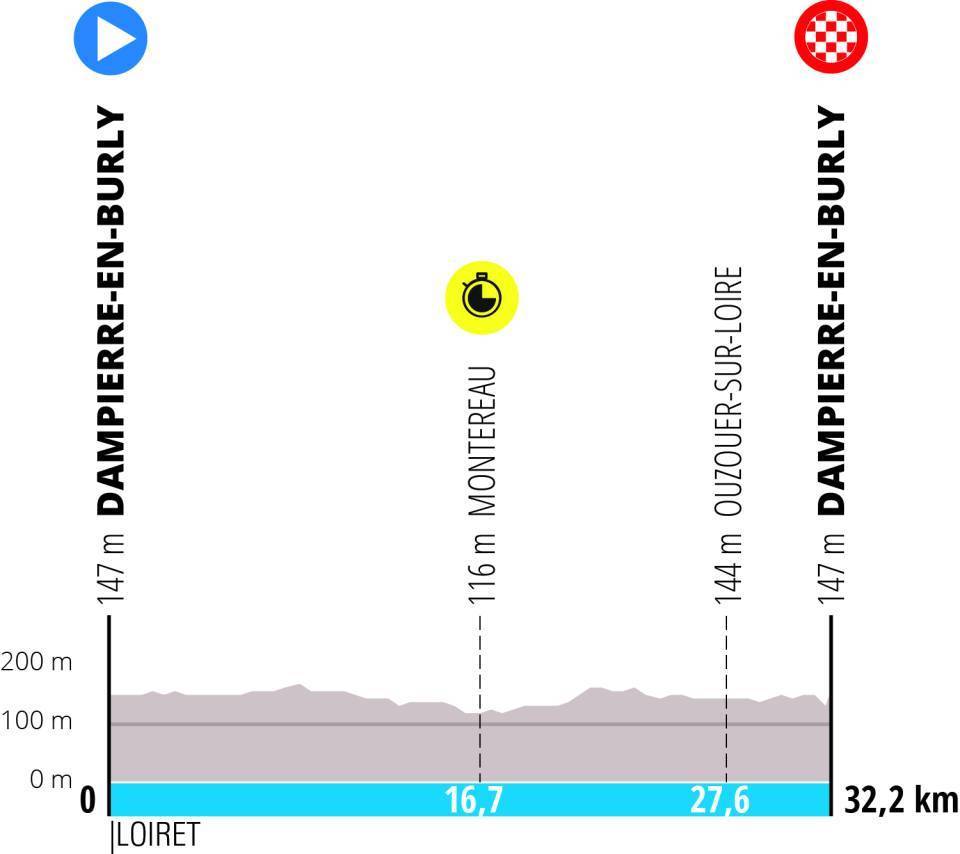
The team time trial is back. A staple of the sport for many years, the discipline has fallen out of favour of late, only Tirreno-Adriatico regularly has one. Otherwise it’s become rare, Vuelta a Espana uses it from time to time, the Tour de France last had one in 2019 and the Giro d’Italia hasn’t had one since 2015. The Critérium du Dauphiné in 2018. But Paris-Nice? Not since 1993 when ONCE won and their rider Alex Zülle went on to win the overall. The course here is flat, close to the Loire river and the just-reopened giant Dampierre nuclear power plant.
The twist here is a rule change where the time won’t be taken on the fourth of fifth rider like usual, but the first rider across the line from each team. So a team can burn through their riders along the way and then have their last rouleur “lead out” their GC leader; or adopt another strategy to unleash their best time trial rider and take the stage win. But every rider is credited with the time they cross the line, so a GC contender left behind by their team will lose time. Either way no longer is a team as fast as their fifth rider. It’s novel for Paris-Nice but has been used in team time trials in the past, indeed the concept of a TTT has changed a lot of the years but that’s for another day.
Stage 4

A route into the Massif Central, more specifically the Montagne bourbonnaise for the first uphill finish. After Vichy, it goes over the Col du Beaulouis, used in 2020 and at the top was an intermediate sprint despite being the hardest climb of the day… and again this time there’s a sprint despite it being a proper pass.
Then comes the summit finish at the La Loges des Gardes, a mini ski-station and activity park and a “new” summit finish that’s probably worth a recon. It’s via a small road that regularly tops 8% making it a selective finish.
Stage 5

It’s not a culinary or gourmet route this year but here’s a food connection for this stage as the start in St. Symphorien is home of the Cochonou saucisson that is a big Tour de France sponsor. It’s over the hills to help a breakaway form before a dash down the Rhone valley. There are two late climbs, the first isn’t hard but it is exposed to the wind. The second of which to Aleyrac was a 2nd category climb when tackled in 2015 on a day when a few heavyset sprinters were dropped. It should be a sprint finish in St.Paul and as ever, watch out in case the Mistral wind’s blowing.
Stage 6
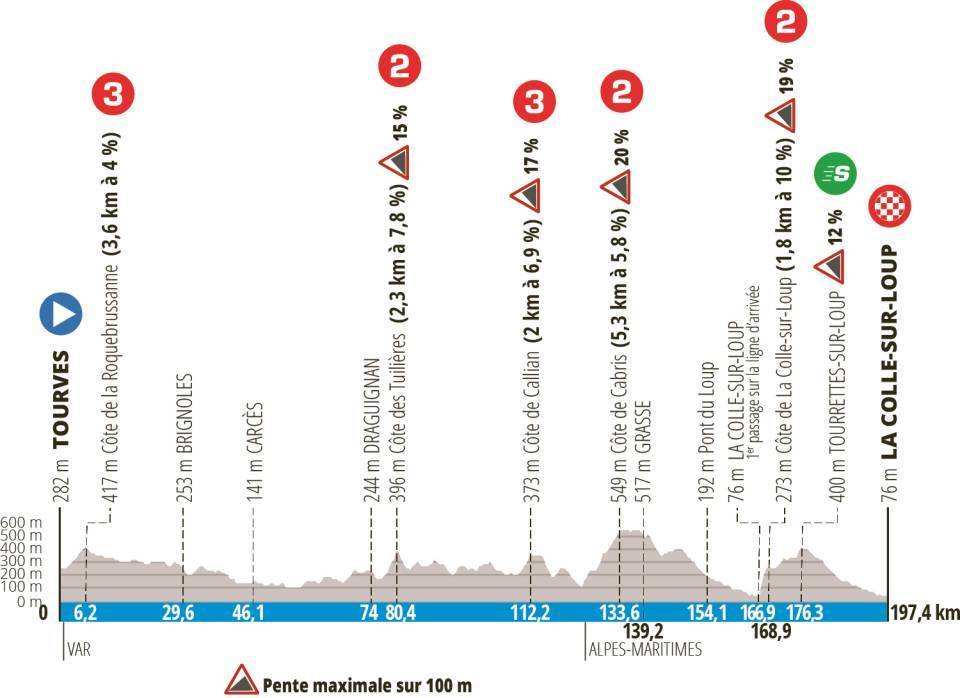
The “wall” stage with a collection of climbs all with steep sections before the finish in La Colle-sur-Loup just behind Nice. There’s no map yet so the exact route isn’t know but it looks like the final climbs are on narrow backroads and that the last climb is the same as the hectic stage of 2018 where Rudy Molard won from the breakaway.
Stage 7
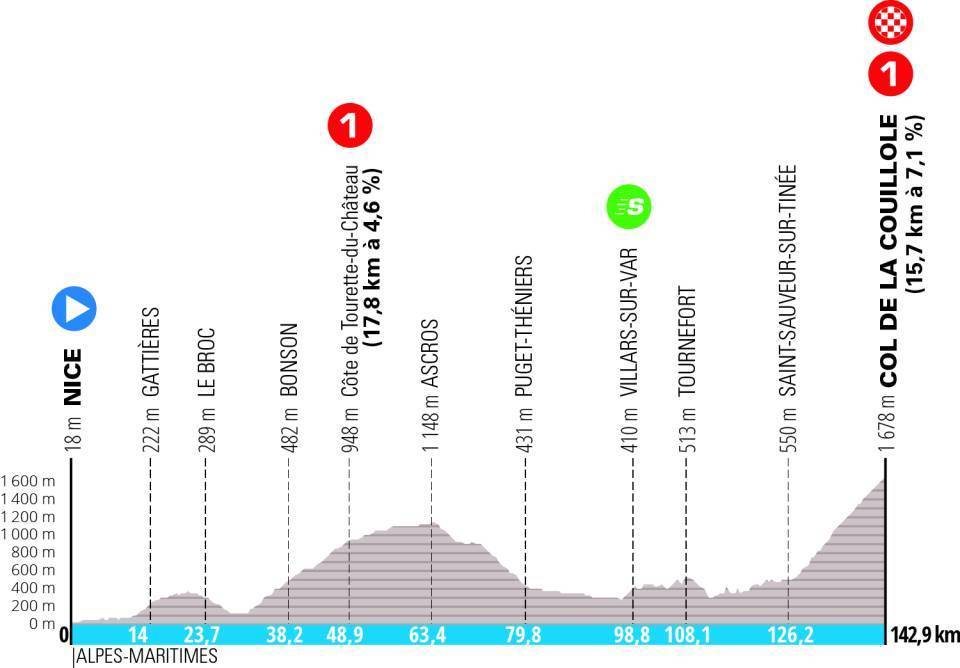
The summit finish stage with the Col de la Couillole on the eastern flank from the Tinée valley. At 1,678m it’s a high climb but arguably the length is the defining feature, 15km at 7% is a lot for March and it’s largely a gradual climb, riders will crack one by one under the pace.
Stage 8
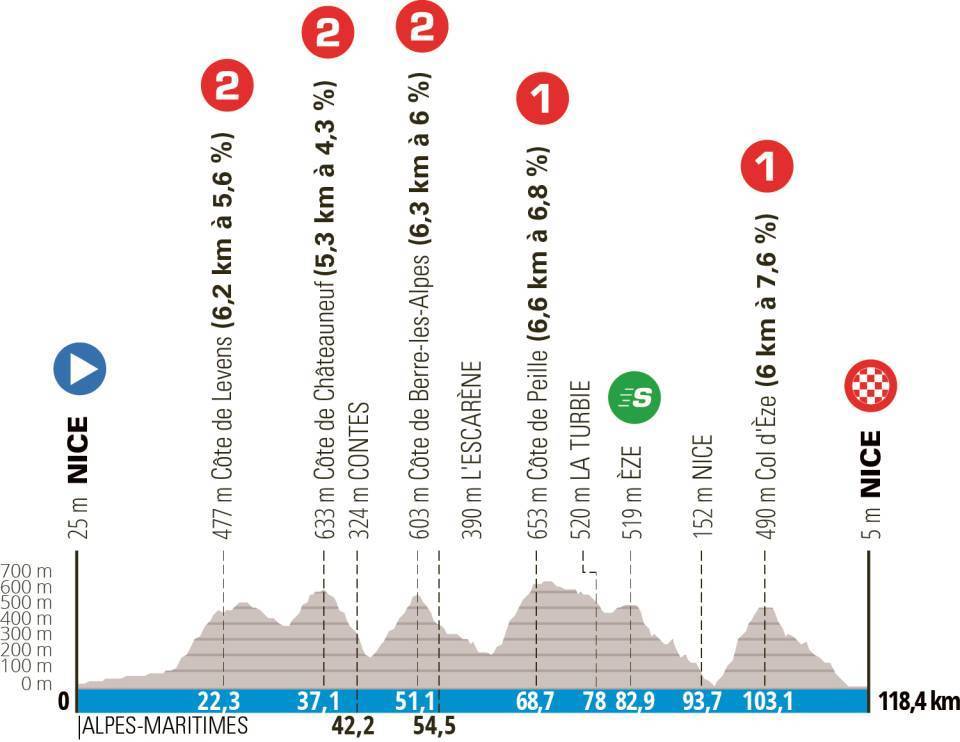
The now traditional dash around the hills behind Nice with the steep climb to Peille, Eze and down to Nice before tackling the Col d’Eze. Look closely at the profile and the final climb has a steep middle section, this is not the traditional route up but a copy of last year’s route with the the Chemin du Vinaigrier and a kilometre at 13% before picking up the main road.
The Verdict
The novelty is the return of the team time trial and at 32km there’s the chance for the big squads to take time and the rule change is a curiosity, it’s a break from the UCI rulebook but organisers can ask for derogations and if it works, maybe it could become a feature and it’ll give team managers plenty to plan and something to talk about on a Tuesday afternoon.
The other early stages offer sprints but will be enlivened if the wind gets up and race takes on the familiar pattern with an uphill finish in the Massif Central, the Rhone valley, a hilly stage, summit finish and the now classic Nice-Nice stage. All the ingredients are there for a lively race.
Teams
The 18 World Tour teams, with automatic invites for Total Energies and Lotto-Dstny and wildcards for Israel-PremierTech and Uno-X, the same as the Tour de France. It’s an obvious choice for Paris-Nice and the Tour de France but we’ll see if anyone else gets a look-in at the Dauphiné in June or if the World Tour is this de facto 18+2+2 selection.
Riders
Jonas Vingegaard (Jumbo-Visma) is the headline attraction and thanks to the team time trial, already the obvious pick for the final win. Last year’s runner-up Simon Yates returns while Romain Bardet and David Gaudu take part and will hope to avoid hopes being dashed in the crosswinds.

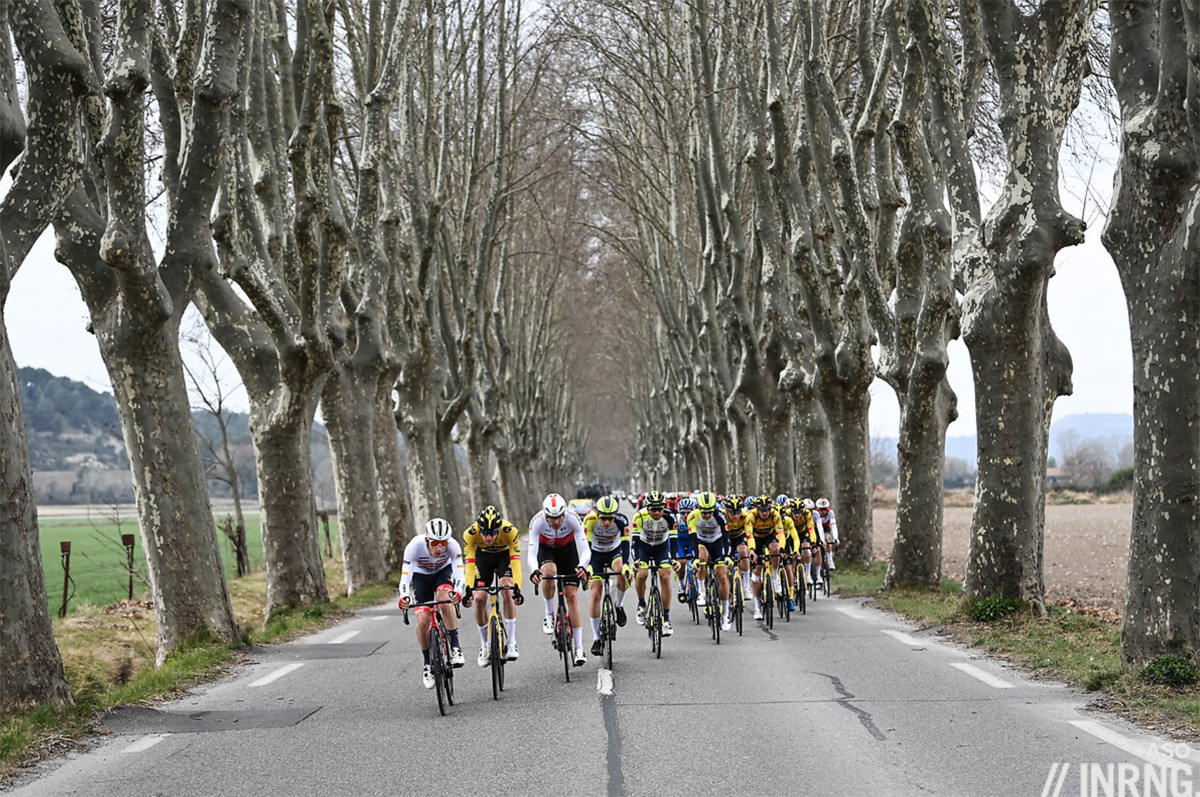
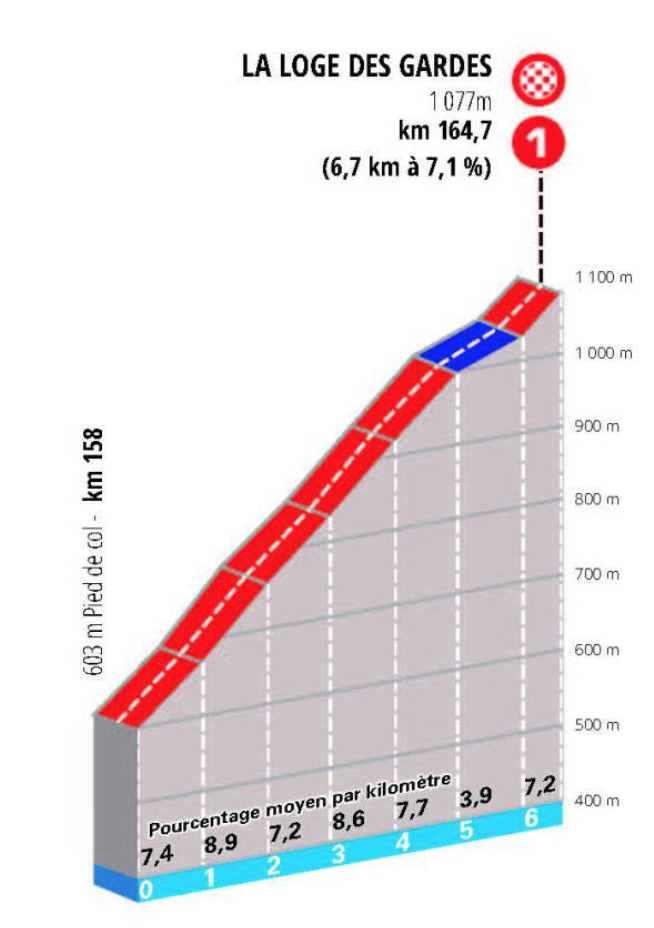
I have no idea if the TTT rule change will result in bigger or smaller gaps for the GC contenders.
Likewise, am still thinking it through. Normally it would still pay to keep as many riders together over the course as a team is going to be faster than one rider. But if riders can go into the red in order to pull for others as they get closer to the finish, that’s interesting… but also risky if the rider on the wheel has less shelter etc.
Bet Dan Brigham is loving it!
Where did that R come from?
Utah?
Potomac – that made me laugh. Thank you
Please explain?
ZigaK – should have been Bigham not Brigham (as in Brigham Young the mormon who mostly live in Utah therefore … )
That length of team time trial in a race of eight days surely all but guarantees that the winner is from a big team.
Unlike all the 0ne-week WT stage races with a 30km ITT that are won by riders from small teams.
“a GC contender left behind by their team will lose time”. So, all teams with GC hopes will make sure their GC-man crosses the line first. Will it make a big difference?
Otherwise, a similar course and let’s hope for some good weather, and if Bernal races maybe a look at his form.
Presumably the GC man just needs to be in the first group, with no gaps between the riders, not necessarily the very first across the line. The optimal composition of that group is one of the things for the strategists to consider. If the stage win is a priority maybe the GC guy can afford to lose a few seconds too.
Tactically it’s more nuanced than a standard TTT. Whether that translates to more interesting racing, we will see. There’s certainly scope for a GC contender to fall away because of the wrong approach rather than just because the team isn’t strong enough.
As a long TT it probably pays for riders to stick together for longer so we’ll see if it has a big effect, maybe if it was shorter it could pay to have riders really go into the red. The idea, say the organisers, is to have top of the GC less dominated by teams, eg the first seven places are Jumbo, the next seven Ineos etc and that the following day’s significant summit finish will help shake things up further.
32k is a long tt(?)
Bring back the days of hinault.
32km or 64km.. and it wouldn’t make so much difference to the effort, it’s an aerobic effort where a group can work well together. Was thinking more of 5-10km, here you could have a dedicated lead out rider, others primed for specific pulls etc.
You mean these days of Hinault?
[img]https://i.imgur.com/VMScW6N.jpg[/img]
If the organizers want the GC less dominated by teams why not have a ITT instead? As pointed out, if it was a half as long (16km) it would be more interesting, as teams could go nuts. Now, it appears that the rule change will not make that big of a difference. Is this some “try out” for next years Tour, I wonder.
+1 for your initial point.
I was thinking what would make it interesting would be team relays with Madison changeovers!
Ti-Ad total clone ^____^
…which is great news, of course. Now they just need the top-quality startlist, but with this improved course and a little bit of climate change, it’s a matter of a few years time.
Probably, current Ti-Ad is also leveraging on sheer geographical proximity with Strade Bianche and Sanremo.
Anyway, as I’ve long defended here I’m with inrng about the nice sides of two great races being on at the same time: due to its specific features cycling needn’t be 100% as other sports.
It could be that we will not be able to enjoy two great races being on at the same time after 2025 – if it’s true that the UCI plans to reform the WorldTour calendar: “We are not going to allow any more overlap in the men’s calendar.”
It would seem, then, that either P-N or T-A has to move. (I cannot imahine the UCI dropping one of the two out of the WT calendar…)
But I can imagine the UCI dropping their own plans once again…
(Alas, sometimes they actually enforce the rules or their ideas, especially when not that brilliant)
Just to go off topic a moment, “We are not going to allow any more overlap in the men’s calendar.” How is this going to improve matters? To my mind, it seems that it will only punish smaller teams and their riders.
I used to think it was odd that the sport has opposing races, eg Paris-Nice and Tirreno-Adriatico at the same time, or the Vuelta is on when other World Tour races like Plouay and Québec/Montreal are on, Formula 1 doesn’t have two GPs on the same day, tennis doesn’t have grand slam clashes (although a lot of other tennis tournaments overlap)
… but it works this way in cycling because we have so many riders and they’re suited to different terrain with climbers, sprinters and other body types. You can have the Tour of the Basque Country on the same week as the Ronde van Vlaanderen precisely because of this.
Also lot of the TV audience is national to start with, eg Paris-Nice is on France Télévisions but T-A is not, those of watching on Eurosport/GCN are a relatively small bunch so avoiding the clash doesn’t necessarily free up an audience of people who would be watching one race and not another.
But one long term project is to have the World Tour as a complete TV package, so if a broadcaster bids for the rights for the Tour de France, they also get P-N, T-A, Flanders etc and so could show a lot more races on their channels. This is promising.
Easier said than done, for example UK broadcaster ITV has the rights to ASO’s races and shows the Tour live of course, but don’t think it has P-N live, it offers highlights, and there’s no Liège at all etc; only a handful of broadcasters offered live coverage of the Tour de France Femmes despite owning the rights. So you can sell the package with the rights to a lot more races… but it doesn’t mean a broadcaster will supply commentary, put it on their schedule etc.
So a lot of detail to work out. The calendar is probably the easy bit although it’s going to involve give and take from ASO, RCS, Flanders and some effort to ensure these three don’t carve up the sport for themselves.
Thanks for the post. Apparently there is a French law that says that the Tour & Paris-Roubaix must be shown on public TV which will cause a problem. Also as you point out more money for TV-rights will not necessarily mean more cycling on TV.
Hope this is ASO trying to make the TT element of GTs more engaging. Everyone in the media knows they don’t get the viewers for ITTs because highlights are fine. And normal TTTs are strictly for the first week of a GT. This format could come in the final week and really shake things up.
If they really wanted to shake things up, they could do a non-team TT where groups of 18 riders, made up of one from each team, set off and it’s individual times across the line to count. Team managers have to say in advance what order their riders will go off, and so 8 lots of quasi-randomly assembled riders set off at 5-minute intervals. It’s up to them as individuals and collectively to decide whether they want to help each other go fast, or even whether to stick together.
This I would watch right the way through.
I love it.
As the composition of the groups would be the deciding factor, there would have to be a very smart rule to determine who gets to choose and at what order.
Certainly an interesting idea and I appreciate the out-of-the-box thinking, but I suspect that could lead to deliberate negative raceing. Imagine someone from a rival team not wanting to help a rival GC leader.
That’s kind of the point. And it’s what a lot of racing is like already.
No other team member is going to pull for a top favourite. If two top favourites happen to be on the same Start, will they help each other or will they mess around with attack-and-follow, which could let another lot of starters do better? If every top favourite is in separate Starts will it just be them pulling the whole time?
– If there has to be a race against the clock, why not make it a lot less predictable?
Surely, the GC contenders would always ride on the front – whether in the same group or not – not to do so would be potentially race-ending. There’d be a lot of people with no interest in riding at all – only those who care about their GC position and/or those with a chance of getting into yellow on the day.
It might be an interesting day, but would it be better for the race as a whole? Would you want a grand tour to be decided by something so random/gimmicky?
Does cycling need to be ‘livened up’ in this way?
A simpler answer seems to be just don’t have team time trials: they give too much advantage to big teams, who already have enough of an advantage. If you look back at previous grand tours you see some GC contenders two minutes behind their rivals just from one TTT.
Years ago, having a TTT in a race might have meant that teams had to choose between domestiques who were good at that and those good in the mountains, but nowadays there are so many domestiques who are good at both – the likes of Porte, WVA, Rohan Dennis, Castroviejo – and most of those types are on the big teams as well.
And if you look back at previous grand tours you will see some GC contenders two and a half minutes or more behind their rivals just from one ITT.
The argument that TTT unduly favours big teams is plainly wrong and has been wrong for years. There are many reasons for this including but not limited to an increase in athletic ability and technical approach across the depth and breadth of the World Tour peloton.
But with an ITT, the rider gains or loses the time purely down to their own ability, or lack thereof, whereas in a TTT, the rider can lose time – despite being quite good at a TT themselves – because they are on a weak team.
So, it’s not the same thing.
Quite a few smaller teams can afford a grand tour contender but not all the high-priced domestiques who can ensure that they can do well in a TTT. Thus, the TTT favours big teams more than an ITT does.
Teams that have done well in TTTs have not necessarily always been the best teams in general. American teams tend to have good TTs, but are often weak in other ways. French teams often have weak TTs, but didn’t FDJ have a good one at the Vuelta?
Nice win by Plapp to start 2023. He made two 2022 TdF stage winners look ordinary in the final which suggests that a real one day race is a lot more meaningful that individual GT stages.
We’ll see what he can do in the TDU soon which is a very different race than it used to be with the TT opener and more climbing. Then the UAE Tour too where he was impressive on the climb.
You already know Jumbo-Visma will scorch through this new format TTT. They will make a thing of this. Finishing with Van Aert and a GC leader in tow. If the other teams don’t take this seriously they will take minutes and the GC will be done on stage 3.